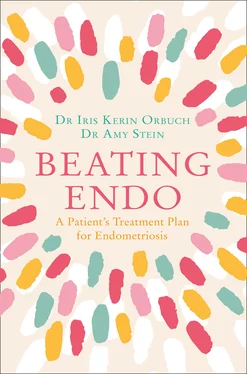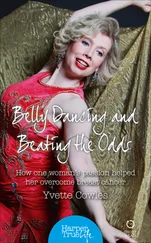Endo doesn’t just affect the pelvic region. The body’s response to the inflammation it causes sensitizes the central nervous system, and if you don’t know what’s going on—as I didn’t—this sensitization fucks with your head. If your head’s not right, there’s a good chance you’re in distress. This is where endo crosses the line from a physical ailment to an emotional one too.
On the physical level, learning to live with the pain during most of my adult life compromised my pelvic floor. Without knowing it, I was compensating for the movement of organs over decades and developing postural habits to avoid painful intercourse. At the same time, I was also putting up with excruciating periods and bowel movements, chalking it up to the fact that I was a busy, stressed, ambitious person.
By the time I met Dr. Orbuch, I was at my wit’s end. But being able to talk with her, to ask questions and receive answers, was the beginning of a new chapter. I never looked back.
First, she asked me to change my diet and start seeing a physical therapist regularly. Let me be honest. I balked. I was a healthy woman who regularly exercised. What difference would a new diet and more money spent on physical therapy make? Let me save anyone from having the same doubts: WHAT SHE ADVISED HELPED! Sticking to an anti-inflammatory, low-potassium, low-acid, dairy-free diet hugely lessened my random pelvic burning and meant almost no pain during intercourse. I didn’t do the physical therapy, because I didn’t believe it would work. That came later. Again, please learn from my mistakes: Do it immediately!
On December 17, 2018, I underwent excision surgery. Four hours and five incisions later, I woke up to discover that fourteen pieces of endometriosis, ranging in diameter from two millimeters to two centimeters, had been pulled out of my abdomen. Endo had grown as far up as my diaphragm. It was so invasive that some implants had obliterated the cul-de-sac between my cervix and rectum, pushing my uterus all the way to the left side of my pelvis. My case is certainly not the worst I’ve heard of, but it explained a lot about the pain and discomfort—not to mention the emotional stress—I’d suffered from for the past twenty years.
Afterward, Dr. Orbuch insisted on physical therapy. Physical therapy is imperative after shoulder, knee, or any surgery. What’s the difference? My body formed physical habits to fight the pain and it needed realignment. My organs, particularly my colon and uterus, had been pushed to places they did not belong. I needed help.
That was when I met Amy Stein. I walked into her office a week after surgery and burst into tears.
“I feel like everything is falling apart and this is never going to end,” I cried as I fell into her arms. “I don’t know why I’m here. I don’t like physical therapy. I can just breathe and meditate through this, my boyfriend is being weird, my whole family is here for Christmas, the pain won’t go away, and every time I think about something I have a surge of anxiety that rushes from my groin all the way up to my heart.” I kept crying.
She hugged me, which I don’t think is required for her job, but I am sure has become a staple of it. She worked on the parts of my body she could at that time, told me this was all normal, and explained the importance of a holistic approach to the recovery. I saw her every week, and she started doing deeper and deeper work. I began implementing her exercises, and slowly, the internal pain lessened. My work with Amy Stein was IMPERATIVE to my recovery. Physical therapy realigned my body after decades of damage.
Two and a half months out of surgery, I was remarkably better. For the first time in more than a decade, I had a pain-free bowel movement during my period. It’s one of those little victories I can’t scream about on the subway, but those of us reading this book will understand. It’s a big deal to take a dump without feeling like a knife is stabbing you through the groin and you want to vomit all over your bathroom floor.
It wasn’t until this recovery process that I realized how pervasive this condition truly is. It affected EVERYTHING in my life. I don’t want to blame it for all my problems, but having a condition you don’t know about for twenty years plays a huge part in making you feel out of alignment, not just physically, but also mentally, emotionally, and spiritually.
It’s simple: To fight this all-encompassing condition, recovery has to be all-encompassing as well.
That’s where this book comes in. It doesn’t just outline a plan to beat endo; it’s also a manual for helping women feel less alone.
I used to be scared of talking about my endometriosis. My greatest sadness, and probably the most costly to my sanity, was this self-inflicted shame. I didn’t know how to talk about what I was feeling without having a name for it, and so I stopped talking about it altogether.
Endo might be an “invisible disease,” but that should not mean that those of us who have it must also become invisible. It’s important to talk about it, to destigmatize pelvic pain, and to look toward solutions. Beating Endo is a way to start that conversation, not just to educate those of us with endo about how to survive it, but also to educate our friends, partners, and families. The more people know, the less stigma there is, and the less stigma there is, the more of us will be able to beat endo.
I watched my husband back out of our driveway as our little chestnut-haired boy waved from the back seat of the car. “I’m sorry you are hurting again, Mommy—I’m sorry you have to miss the baseball game,” he said. “We’ll call you when the Dodgers score.”
And just like that . . . the car made its way down the cherry-blossomed street without me, once again.
I kept waving to my son and husband, while desperately clutching the bright red hot water bottle tucked into the waistband of my sweatpants. It was another month and another horrible, terrible, god-awful menstrual period.
I had become so reliant, so sickly dependent, on my almost a dozen heating pads and water bottles, I couldn’t imagine going anywhere without them. They provided temporary relief from my painful cramps but couldn’t soothe my confused head and broken heart. I was sick and tired of hurting. How many more games, practices, ski trips, teacher conferences, birthday parties, weddings, and date nights was I going to miss from this otherworldly pain? Was there no end to this torture?
At forty-seven years old, I was turning into the frog submerged in boiling water. The frog sits and sits as the heat is turned up 5 degrees every day until one day it realizes it’s about to become the soup du jour.
Like the frog, I just kept rising up—raising the ceiling for dealing with my pain until I was absolutely boiling over.
My rock bottom came when I was driving my mom and son around Melrose Avenue in Los Angeles. We’d just finished a cake-decorating class and were reliving every delicious detail. As we laughed and joked about our fondant and icing trays, I suddenly felt a strong jolt in my right side. Holy God! This was debilitatingly painful. Like a fierce electric shock.
I had to pull over, stomach throbbing, because of an INSANE amount of pressure in my right abdomen. Yanking the car over to a side street, I hobbled out and collapsed in the grass of someone’s front yard. It was a small, beige-brick 1970s house. I couldn’t help but look in the window and see a nice family sitting down to a chicken lunch. I was wiggling in their front yard, ten feet away from where they were eating. They stared at me in horror—like I was a crazy person.
I grabbed my stomach. Something was bursting in my right side and I could not breathe. I was so embarrassed but in so much pain. My mom ran over to me, and through a panicky breath said, “Come on, honey. I’m driving you to the emergency room. Cedars is five minutes away.”
Читать дальше











